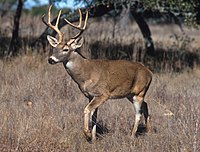
Photo from wikipedia
Abstract In heterogeneous landscapes, resource selection constitutes a crucial link between landscape and population‐level processes such as density. We conducted a non‐invasive genetic study of white‐tailed deer in southern Finland… Click to show full abstract
Abstract In heterogeneous landscapes, resource selection constitutes a crucial link between landscape and population‐level processes such as density. We conducted a non‐invasive genetic study of white‐tailed deer in southern Finland in 2016 and 2017 using fecal DNA samples to understand factors influencing white‐tailed deer density and space use in late summer prior to the hunting season. We estimated deer density as a function of landcover types using a spatial capture‐recapture (SCR) model with individual identities established using microsatellite markers. The study revealed second‐order habitat selection with highest deer densities in fields and mixed forest, and third‐order habitat selection (detection probability) for transitional woodlands (clear‐cuts) and closeness to fields. Including landscape heterogeneity improved model fit and increased inferred total density compared with models assuming a homogenous landscape. Our findings underline the importance of including habitat covariates when estimating density and exemplifies that resource selection can be studied using non‐invasive methods.
Journal Title: Ecology and Evolution
Year Published: 2022
Link to full text (if available)
Share on Social Media: Sign Up to like & get
recommendations!